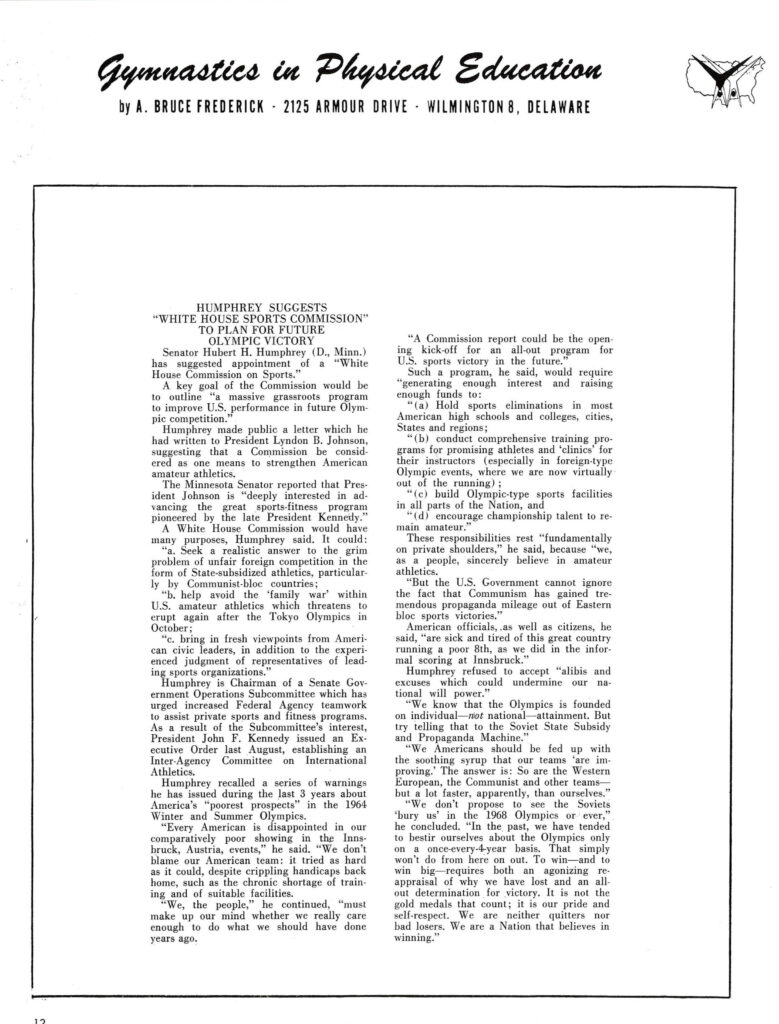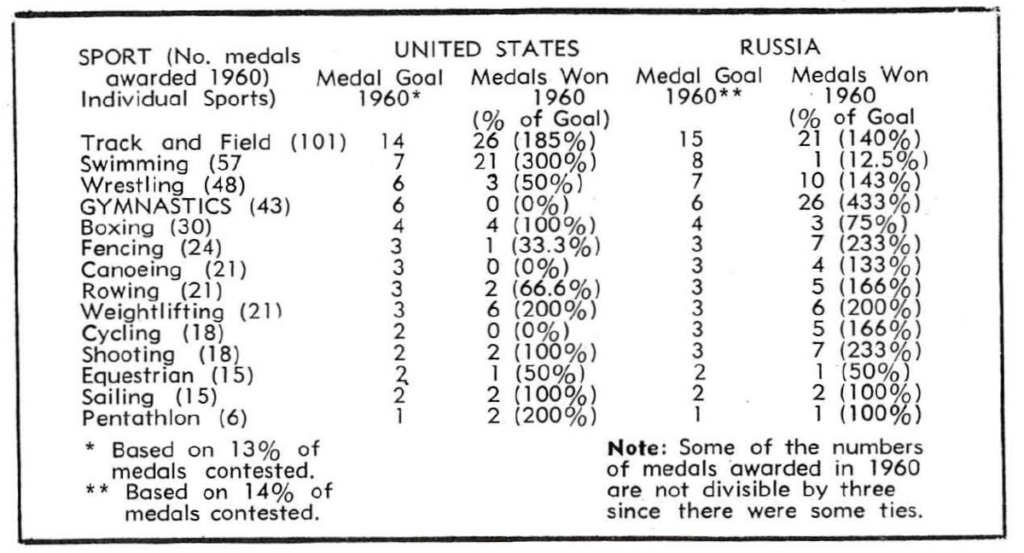Even before the U.S. selected its teams for the 1964 Tokyo Olympics, American politicians were concerned about the nation’s performance.
After the 1964 Winter Olympics in Innsbruck, Austria, Senator Humphrey of Minnesota wanted to create a “White House Commission of Sports.”
Why? Because the Soviets were kicking our asses, and it was not a good look for the United States because Americans were winners.
He didn’t actually say that. Here’s what he did say:

“But the U.S. Government cannot ignore the fact that Communism has gained tremendous propaganda mileage out of Eastern bloc sports victories.”
American officials, as well as citizens, he said, “are sick and tired of this great country running a poor 8th, as we did in the informal scoring at Innsbruck.”
“We know that the Olympics is founded on individual — not national — attainment. But try telling that to the Soviet State Subsidy and Propaganda Machine.”
“We Americans should be fed up with the soothing syrup that our teams ‘are improving.’ The answer is: So are the Western European, the Communist and other teams but a lot faster, apparently, than ourselves.”
He concluded:
“We are a Nation that believes in winning.”
What did this have to do with gymnastics?
To avoid nuclear conflagration, the U.S. and the Soviet Union displayed their power and dominance in other areas, including Olympic sports like gymnastics.
Senator Humphrey didn’t single out gymnastics as a lagging sport. Nevertheless, the U.S. gymnastics community took his remarks as a warning.
In March of 1964, Modern Gymnast printed a comparison of Soviet medals to U.S. medals. At the 1960 Olympics, the U.S. won zero medals in gymnastics. Meanwhile, the Soviet team won 26 of a possible 43.

In a column for Modern Gymnast, Bruce Frederick wrote:
The sport of Olympic Gymnastics is fourth ranked according to the number of medals offered. We [the United States] can not afford to be content with a non-medal performance.
Modern Gymnast, March 1964
What could the U.S. do better?
In Frederick’s opinion, a lot of the problem stemmed from education:
The American public is not aware of the value of gymnastics to each boy and girl of public school age regardless of potential ability.
But he made another point that deserves to be highlighted.
Gymnastics has a special value for girls in that it is one of the very few activities in which a girl may excel without being compared with a boy. The four Olympic events are specifically designed to fill the special physical needs of girls.
In other words, we need to place more emphasis on women’s gymnastics because it’s not like other Olympic sports like track and field. Gymnastics is a sport that was actually designed for women.
- My thought bubble: I take that to mean that Frederick thinks it’ll be easier to attract women to gymnastics because they won’t feel like they are playing a men’s sport.
- It’s also interesting that he says the WAG events are somehow designed specifically for female bodies. 🤔
Anyway, Frederick’s words echo what Admiral Thomas J. Hamilton said during a conference organized by the Women’s Board of the United States Olympics Development Committee.
Our greatest chance to improve in the Olympics are in women’s sports.
Modern Gymnast, January 1964
Of course, the U.S. women didn’t win any medals in gymnastics in 1964, and neither did the men. The women finished ninth out of ten teams. The men finished seventh out of 18 teams.
In the post-mortem analysis of what went wrong, there were many theories about why the U.S. gymnasts weren’t more successful:
- Inflated domestic scoring, leading to inflated expectations at international events
- Lack of international experience
- Lack of amplitude
- Side note: “Amplitude” is going to become the buzzword of the late 1960s
- Lack of education at all levels
- Not enough all-arounders
- Too much emphasis on event specialists at the high school and college levels
- Not enough time on compulsories
- Lack of a centralized training system or at least a major city where gymnasts tend to live
- Copying the routines of the leading teams rather than innovating
And more. (Some of those probably sound familiar to today’s gym nerds in the United States.)
But the seed had been planted: If Americans were going to win more Olympic medals and beat the Soviets in medal counts, the country needed more emphasis on women’s sports.
🤑💵💸💰🤑💵💸💰🤑💵💸💰
Not only was there a political battle on the line; there was funding on the line.
For example, in 1967, the U.S. State Department allocated $90,000 for participating in the Student World Games. Gymnastics, it was anticipated, would receive $0 because the State Department “wanted winners” (Modern Gymnast, November 1966).
(Yes, you read that correctly. The U.S. State Department — the department in charge of foreign policy — was doling out money for athletes to attend competitions.)
U.S. gymnasts weren’t winners just yet. At the 1966 World Championships in Dortmund, West Germany, the U.S. teams showed progress.
- The U.S. men finished sixth — just 0.8 from fourth.
- The U.S. women jumped three places — from ninth in 1964 to sixth in 1966
However, remember what Senator Humphrey said? “We Americans should be fed up with the soothing syrup that our teams ‘are improving.'”
So what? Why does any of this matter?
- Gymnastics intersects with politics. There’s this naïve view that gymnastics exists in a realm that is separate from politics. It does not. The history of U.S. gymnastics is inextricably linked to the Cold War. (As are the histories of most U.S. Olympic sports.)
- Gym nerds knew that politics were on display at international meets.
- Describing the women’s competition at the 1966 World Championships, Herb Vogel wrote: “The World Gymnastic Championship is more than a competition between the leading amateur gymnasts of the world. It is a battle of politics and international prestige where only one place is actually being contested.”
- “We are a Nation that believes in winning.” Doing gymnastics for the sake of doing gymnastics was not enough. If federations wanted funding, they needed to produce winners, especially in sports with many medals at stake.
- Whether we like it or not, this attitude still exists today. If you look at the budget at USA Gymnastics, they spend more money on WAG than MAG. And WAG brings in more revenue and more medals than MAG.
- The chicken or egg problem. Governing bodies want to fund medal winners. But how do you become a medal winner without the $ required for training and for traveling to competitions?
- This predicament will sound familiar to many gymnasts.
What’s next?
From 1964, we’ll jump to the 1966 World Championships in Dortmund, West Germany, where there will be another judging controversy. This time, it’s on the women’s side. And this time, it’ll involve a U.S. gymnast.
But we’ll get to that after the 2021 Olympic Games.